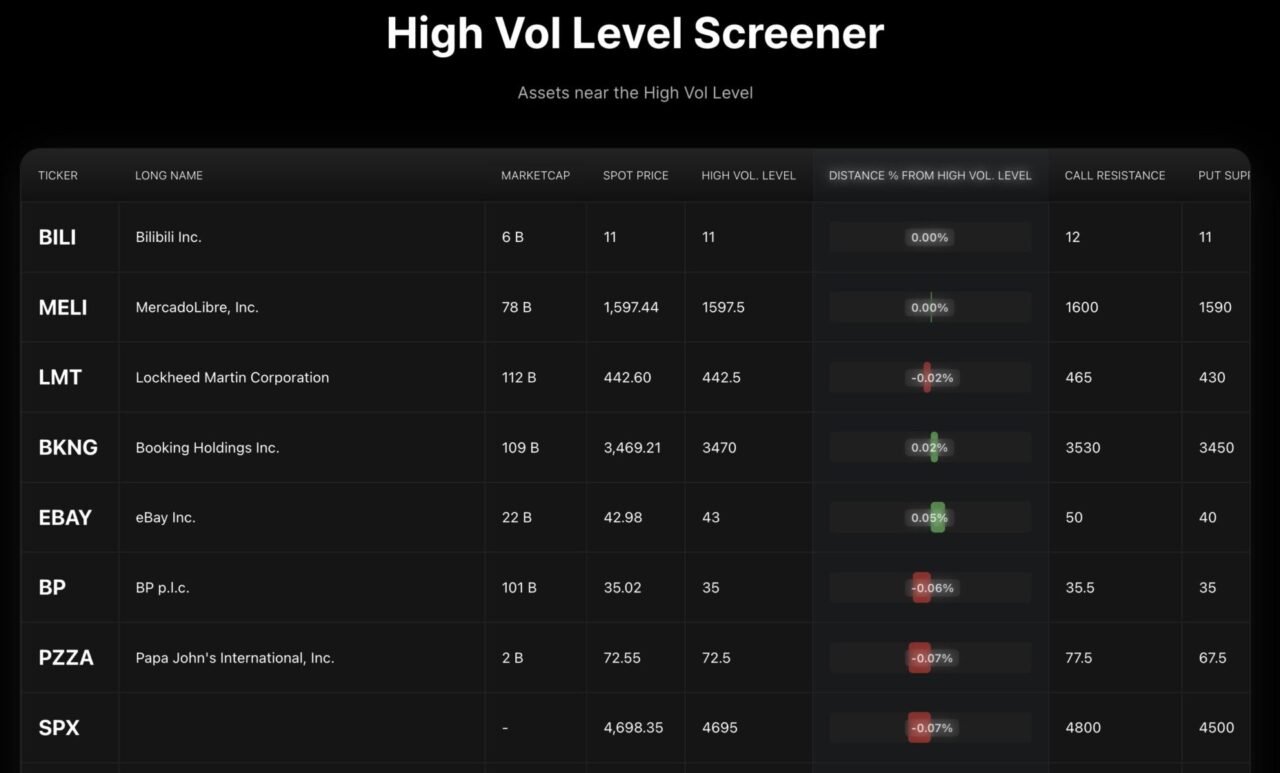Options Screeners

With the Premium Membership not only you will get access to our Q-Models on Stocks, ETFs, Indices, Crypto and Futures but you will also get access to our Premium Options Screeners.
What are the Menthor Q Screeners?
Stocks Screeners are tools that allow investors to filter and search for specific stocks or securities that meet predefined criteria. These criteria can be based on various factors, including fundamental, technical, and other quantitative parameters.
Stock screeners allow investors to filter and sort through a vast universe of stocks quickly. Traders who use technical analysis rely on stock scanners to identify stocks that exhibit specific technical patterns, like moving average crossovers, overbought or oversold conditions, or breakouts.
For investors who focus on fundamental analysis, stock scanners can help them screen for stocks with particular financial characteristics, such as low P/E ratios, high dividend yields, or revenue growth.
With the Menthor Q Screeners you can now receive a daily list of stocks matching quantitative parameters. By leveraging our quantitative models you can now find the most relevant assets and enhance your research. You can find our screeners within the Premium Section of our Discord Server.

Menthor Q Screeners Categories
We divide our Screeners in different categories:
- Gamma Levels
- Volatility
- Gamma
- Open Interest
Let’s now look at them in detail.
1. Gamma Levels Screeners
Gamma Levels are Key Price Levels where there is the most Negative or Positive Gamma based on market positioning in the option chain. By looking at the options data we can define sticky price levels that can help us define our trading plan. We have a series of Guides under our Resources that can help you understand the different Gamma Levels.
Our models use Primary and Secondary levels. The Primary Levels are the Call Resistance, High Vol Level, Put Support. The Secondary Levels are the Net GEX Levels. You can find these levels either by downloading our script in TradingView or by looking at the Net Gex chart.
The Gamma Levels Screeners allows you to search for stocks that are approaching the Primary levels. This is the list of the screeners in this category:
- Call Resistance Screener. It returns the assets with a last price close to the Call Resistance Level.
- Put Support Screener. It returns the assets with a last price close to the Put Support Level.
- High Vol Level Screener. It returns the assets with a last price close to the HVL Level.
- Call Resistance 0DTE / WDTE Screener. It returns the assets with a last price close to the Call Resistance 0DTE or WDTE Level. We wrote an article about 0DTE Options.
- Put Support 0DTE / WDTE Screener. It returns the assets with a last price close to the Put Support 0DTE or WDTE Level.
These levels tend to be sticky levels that can be used for your option spread strategy. In certain cases, based on volatility those levels can act as magnets for the spot price. We can use these scanners to create our directional strategy or our options spread strategy.
2. Volatility Screeners
When trading one of the key variables to consider is volatility. One of the biggest mistakes traders make is to trade on the wrong side of volatility. This is why we have created a set of screeners that can help you define your list based on volatility. We cover Volatility and Strategies in our Academy.
This is the list of the screeners in this category:
- Highest Implied Volatility. It returns the assets with the highest Implied Volatility.
- Lowest Implied Volatility. It returns the assets with the lowest Implied Volatility.
- Highest IV Rank. It returns the assets with the highest IV Rank.
- Lowest IV Rank. It returns the assets with the lowest IV Rank.
We want to use Volatility to define the type of strategy we want to trade. For example if Implied Volatility is high we might want to consider selling options as the option premium increases. We can also look at IV Rank to compare current implied volatility with its history.
3. Gamma Screeners
The next set of screeners is based on our Gamma Levels. When we talk about gamma levels, we refer to those strike prices that have the most concentration of gamma. Those strikes are particularly important for two reasons:
- The levels with the highest gamma can be used to place the strikes for our option spread strategies
- These levels can become very sticky. That means, that intraday those levels can act as magnets to attract the spot price. That works most often when the market is in negative gamma and volatility is high.
These are the screeners you will find:
- Highest Positive DEX expiring with 1 week
- Highest Negative DEX expiring with 1 week
- Positive change in Net Gex and Negative change in Open Interest
- Highest Net Gex expiring within two weeks
- Largest Call Net Gex expiring within two weeks
- Largest Call Net Gex expiring with two weeks
- Largest Put Net Gex expiring within two weeks
These screeners will help you filter those stocks that have most gamma or delta and are about to expiry.
When option contracts expiry, that drives a repositioning of market participants and market makers. That repositioning drives liquidity and market movements.
Being able to filter all those underlying that have most gamma or delta, can also help us identify the ones that have more potential price action. We do the same thing for open interest. Positive or negative changes in open interest drive gamma higher or lower, that once again drives positioning for market makers and investors, ultimately driving liquidity in the markets.
4. Open Interest
Open interest in options trading represents the total number of outstanding or open options contracts.
Open interest can increase or decrease as new options contracts are created through opening trades (buying or writing options) and existing contracts are closed through offsetting trades (closing out positions) or expiration. Increases in open interest can indicate growing interest in those options, while decreases may suggest waning interest.
High open interest is often seen as a sign of greater liquidity, which can lead to narrower bid-ask spreads and easier execution of trades. Low open interest options contracts may have wider spreads and may be less liquid.
Open interest can be used to identify potential support and resistance levels for the underlying asset. High open interest at a particular strike price can indicate a level where traders expect the price to find support or resistance.
Here are the screeners under this category:
- Change in Open Interest.
- Highest change in Call Open Interest in the past week.
- Highest change in Put Open Interest in the past week.
It is important to understand the concept of Open Interest Put Call Ratio. The open interest put-call ratio is a sentiment indicator and is calculated by comparing the total open interest in put options to the total open interest in call options for a specific underlying asset.
How to read the Put Call Open Interest Ratio
The resulting ratio can be interpreted in the following ways:
- Greater than 1: A put-call ratio greater than 1 suggests that there is more open interest in put options than call options. This is typically seen as a bearish sentiment, as more investors are betting on a potential decline in the underlying asset’s price.
- Equal to 1: A put-call ratio of 1 means that the open interest in put options is equal to the open interest in call options. This suggests a more balanced sentiment, and it may not strongly favor either bullish or bearish sentiment.
- Less than 1: A put-call ratio less than 1 indicates that there is more open interest in call options than put options. This is generally interpreted as a bullish sentiment, as more investors are betting on a potential rise in the underlying asset’s price.
This brings us to the next screeners.
- Highest Put Call Open Interest Ratio. Returns the assets with the highest Put Call Open Interest Ratio. A high put-call open interest ratio, where the total open interest in put options significantly exceeds the total open interest in call options, suggests a bearish sentiment in the market.
- Lowest Put Call Open Interest Ratio. Returns the assets with the lowest Put Call Open Interest Ratio. A low put-call open interest ratio, where the total open interest in put options is significantly lower than the total open interest in call options, suggests a bullish sentiment in the market.
- Highest Open Interest. It shows the assets with the highest open interest. High open interest suggests that many market participants are actively involved in that particular contract. It can be a sign of significant market interest and activity in that specific strike price and expiration date.
- Highest Call Open Interest. It shows the assets with the highest call open interest. High call open interest suggests that there is a significant group of market participants who believe the underlying asset’s price will increase.
- Highest Put Open Interest. It shows the assets with the highest put open interest. High put open interest suggests that there is a significant group of market participants who believe the underlying asset’s price will decline.
